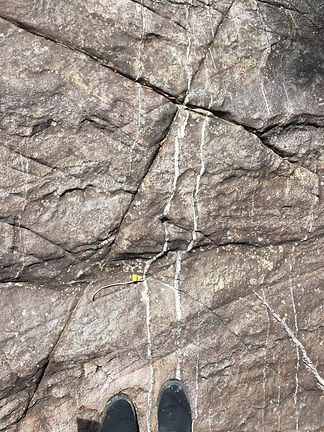

STRUCTURAL GEOLOGY
OF GUNUNG JERAI

INTERPRETATION
Based on the results gathered, an interpretation regarding the formation and stratigraphy of the Jerai Formation can be determined. The tectonic movement and formation of the Jerai Formation can be explained based on the rose diagrams. The rose diagrams are classified into three types of fractures which are igneous rocks fracture, metasedimentary rocks fractures and sandstone fractures. Among them, the major fractures are metasedimentary and igneous because these two groups had undergone tectonic events.

From the fracture of igneous result, the trends show toward NE and SW, which this suggest it coincide with the trend of metasedimentary fracture because the uplift itself not only contribute to the igneous fracture but also to metasedimentary, and this agrees with the theory of the regional geology of this area of study. These igneous fractures happened during Jurassic about (208 to 146 Ma). When the overburden rock was eroded, the granitic rock was exposed to the surface, therefore, the pressure was released (rebound) and granite expanded slightly and consequently exfoliation fractures were formed. The granite rose diagram showed less fractures intensity compared to metasedimentary fractures because the igneous rocks only undergone one tectonic event.


From the present study, we also can estimate the depositional environment of some areas. Based on mineralogical content from the thin sections and some geological features from our area of study, we can estimate the depositional environment. The content of minerals quartz and clay play significant role to determine the type of rock deposited. For instance, it could be quartz arenite sandstone deposited if the minerology content is >90% quartz and this show a shallow marine depositional environment, this rock however will turn into quartzite when it been metamorphosed by granite intrusion. Hornfels usually contain less quantity of quartz but it is dominated by clay which suggests that the depositional environment is deep marine environment before it metamorphosed.
That is the reason of why we could find a sedimentary structure: asymmetrical ripple marks at Taman Rekreasi Gunung Jerai and since the rock is quartzite, the suggested depositional environment is shallow marine or transitional zone. Similarly, Sungai Ketapan is also displaying the same sedimentary features as Taman Rekreasi Gunung Jerai, thus the it was probably formed in the shallow depositional setting.
Moving on, at Sungai Batu Pahat was found a Sinistral fault for both pegmatite vein and tourmaline strings with displacements 8 and 12 cm respectively, whereas the Taman Rekreasi Gunung Jerai has dextral fault with direction angle equivalent to 171⁰


Furthermore, at Sungai Batu Pahat as well as Sungai Ketapan, two types of xenolith (Cognate and Accidental) were found. Cognate xenolith is conceptualised as segregation of mafic minerals that come together to form clogs and this happens due to magnetic susceptibility, whereas Accidental xenolith is formed when the pre-existing rock falls into the magma and it is melt into comminuted fragments of smaller size. However, it is crucial to mention that the accidental xenolith found at Sungai Ketapan is weathered because the minerals comprising the xenolith are softer as compared to those of granite surrounding the xenolith.